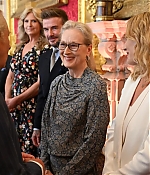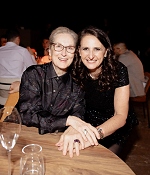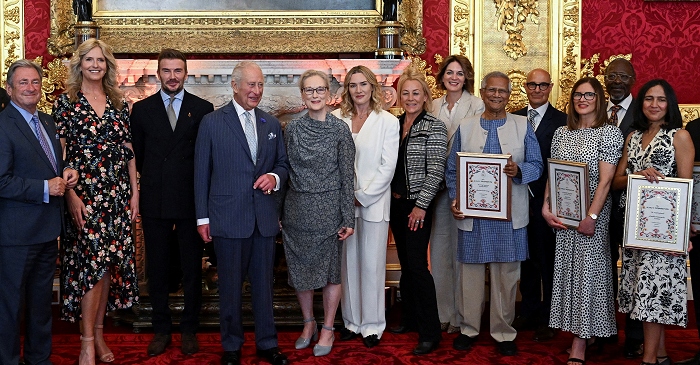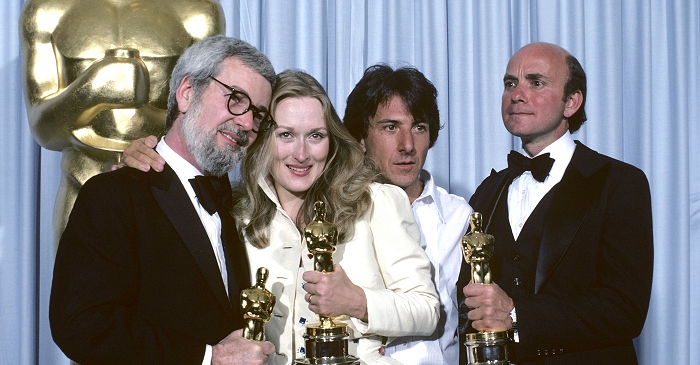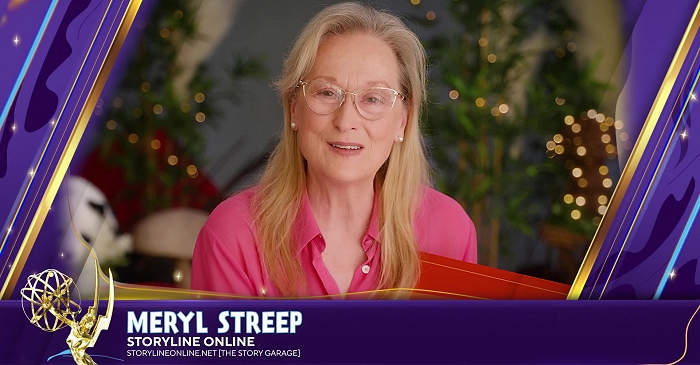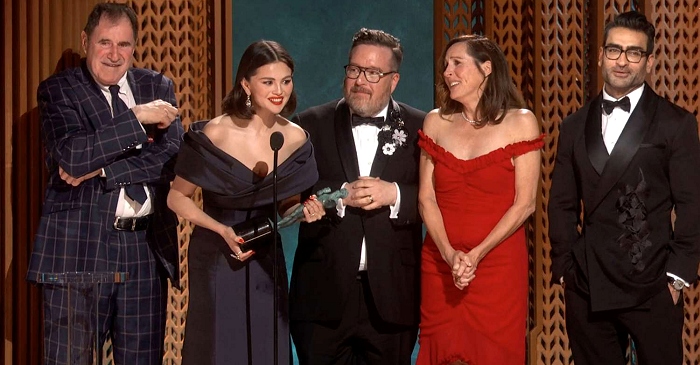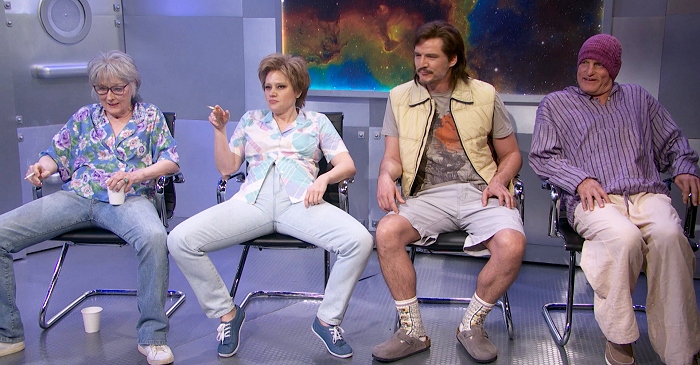|
Simply Streep is your premiere online resource on Meryl Streep's work on film, television and in the theatre - a career that has won her acclaim to be one of the world's greatest living actresses. Created in 1999, Simply Streep has built an extensive collection over the past 25 years to discover Miss Streep's body of work through thousands of photographs, articles and video clips. Enjoy your stay and check back soon.
|
|
A star seen in a new light
The Boston Globe ·
August 11, 2009
· Written by Ty Burr
|
A funny thing happened on the way to the modern multiplex: Meryl Streep became a movie star. Wait, wasn’t she already a movie star? No, she was a Great Actress, which has always been a slightly different beast. But with this past weekend’s release of “Julie & Julia” – selling $20.1 million in tickets after months of increasingly frenzied buzz – Streep stands as a figure unique in a century of Hollywood history: a 60-year-old woman who’s also a vastly popular box-office draw. Her two recent films “The Devil Wears Prada” (2006) and “Mamma Mia!” (2008) together earned a global total of nearly $1 billion. Forbes magazine has listed Streep as one of the movie industry’s top female moneymakers, just behind whippersnappers Angelina Jolie and Jennifer Aniston. A recent article in The Hollywood Reporter ranked Streep with Optimus Prime as one of the 2009 blockbuster season’s surefire bets.
Most strikingly, her new fan base runs wide and deep, cutting across age and, to a lesser extent, gender. On the anecdotal level, my teenage daughters weren’t excited to see “Julie & Julia” because of Amy Adams, whom they liked well enough in “Enchanted,” but because of Streep, whom they adored in “Devil” and “Mamma.” With “Devil,” their generation went in to see Anne Hathaway and came out awed by Streep, who disembowels minions without once raising her voice; it was as if millions of young girls had suddenly discovered what acting was actually about. With “Mamma Mia!” they found the sleepover flick that keeps giving, pairing a delightfully cheesy singalong soundtrack with a Streep who acts younger and dizzier than her onscreen daughter. As Julia Child in “Julie & Julia,” Streep conveys nothing more complicated than joy: Julia’s joy in food, the actress’s joy in playing her, a larger joy in life that rises from the two women’s combined energies. (Poor Amy Adams. She’s stuck playing a modern-day pill.) It’s a movie-star performance of the most serenely confident sort, and it sends audiences out on a cloud.
Again, this is an unprecedented position for an actress of Streep’s vintage. Hollywood distrusts any woman over 40, especially the strong-willed. At the age of 60, Bette Davis was playing a parody of her former dramatic diva in 1968’s turgid “The Anniversary,” her first movie in three years. Joan Crawford was tumbling down the slippery slope of B-movie horror: “Strait-Jacket” (1964), then “Berserk” (1967). Only Katharine Hepburn, Streep’s nearest rival for total Oscar nominations (12 to the younger actress’s 15), was still riding high as she entered her seventh decade with “Guess Who’s Coming to Dinner” (1967) and the following year’s “The Lion in Winter,” for which she won her second and third Academy Awards. Even then, you could argue that Hepburn was but one factor in the commercial success of those films (the death of her costar and longtime lover Spencer Tracy after “Dinner” finished shooting helped make the film a pop-culture memorial), and that her appeal was largely to older audiences (tellingly, she shared the 1968 Oscar with Barbra Streisand, of “Funny Girl”). These were conscious twilight performances, her Eleanor of Aquitaine in “Lion” especially raging against the dying of the light and the perfidy of kings. Streep, by contrast, seems to have entered her second childhood as an actress. She’s having fun, even when playing deadly serious (see last year’s “Doubt” if you doubt it). This is even more remarkable when you consider that for decades her star persona seemed to be made up primarily of vinegar and taffeta. With 12 Oscar nominations and two wins by the turn of the millennium, Streep was our designated Hollywood artiste, with the critical corollary that her movies were unfailingly good for you. On the buffet table of modern Hollywood movies, she was the vegetables.
“The French Lieutenant’s Woman” (1981), “Sophie’s Choice” (1982), “Silkwood” (1983), and “Out of Africa” (1985) were the films that defined Meryl Streep for a generation, and in them she suffered mightily at the hands of men, Nazis, nuclear power plants, and an entire continent. They remain astonishing performances, fully felt and technically detailed, but after a while it was the technique people dwelled on, as if the ability to master accents was somehow suspect. It didn’t help that she lacked the offscreen imperiousness of forerunners like Davis, Crawford, and Hepburn. Streep lives privately, raising her four children with sculptor Don Gummer in the greater New York area, away from the Hollywood hustle. She’s feisty and forthcoming in interviews, but, by and large, it has always been about the art with her. Again, an admirable position (and the correct one) but not one calculated to win a broad following. For better and for worse, we demand that our stars entertain us. Meryl 1.0 was not entertaining. Meryl 2.0 is another matter entirely, and it’s worth noting that this version has been in the works for quite a while. As early as 1987’s “Heartburn,” Streep was playing comparatively lighter roles (there coincidentally as a thinly disguised version of Nora Ephron, her “Julie & Julia” director). She spent the 1990s trying on different hats, gamely essaying splattery special-effects comedy (“Death Becomes Her,” 1992), grim action (“The River Wild,” 1994), and paperback romance (“The Bridges of Madison County,” 1995), followed by a handful of heart-tugging dramas like “Marvin’s Room” (1996), “One True Thing” (1998), and “Music of the Heart” (1999).
Excellent performances all, yet the vaguely medicinal public persona wouldn’t budge. The turning point may have come with 2002’s “Adaptation,” in which Streep turned in a high-wire comedy performance as author Susan Orlean, strung out on orchid dust and going homicidal with lust for Chris Cooper’s maverick botanist. “The Hours” (2002) and “The Manchurian Candidate” (2004) let her play mother hens, one nurturing, the other schemingly villainous. That she was truly lightening up and allowing pleasure to enter her playing could be seen in the generally unseen “Lemony Snicket’s A Series of Unfortunate Events” (2004), in which she’s wonderfully dithery as Aunt Josephine. By 2006, the transformation was complete. Streep appeared in two films that year, both released light years away from Oscar season in the middle of summer. Robert Altman’s “A Prairie Home Companion” debuted a newer, softer Streep, acting a role but recognizably herself as well (and isn’t that what movie stars do, as opposed to great actors – work appealing variations on an established persona?). She sang and joked and genially badgered onscreen daughter Lindsay Lohan, and she appeared to be having a ball. In a film made in the shadow of its director’s imminent death, Streep was a life force. “The Devil Wears Prada” came out three weeks later and sealed the deal. Crucially, Streep’s new audience had no memory of her old roles: The actress was granted the exceedingly rare chance to start from scratch, to reinvent herself in terms of both craft and broad popularity. She hasn’t sold out; rather, she has lifted her young fans to an appreciation of what acting can be: what deep, abiding pleasures it offers, and how many endless insights into humanity. Even better, we – the older generation who thought we knew what “Meryl Streep” meant – can now see her through our children’s fresh eyes. My own revelation came early on in “The Devil Wears Prada,” after Miranda has packed off Hathaway’s Andy Sachs with her signature dismissal: a soft “That’s all” that cuts like a stiletto to the heart.
One of my daughters leaned over to me and whispered, “That’s Meryl Streep? She’s amazing.” In that moment, a star was born.


